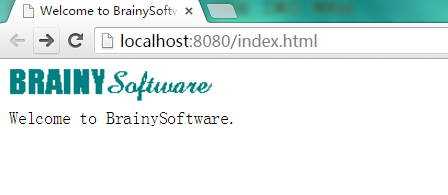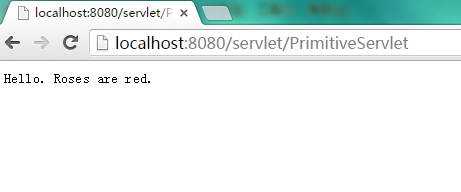标签:
上篇写了一个简单的Java web服务器实现,只能处理一些静态资源的请求,本篇文章实现的Servlet容器基于前面的服务器做了个小改造,增加了Servlet请求的处理。
添加依赖:
<!-- https://mvnrepository.com/artifact/javax.servlet/servlet-api --> <dependency> <groupId>javax.servlet</groupId> <artifactId>servlet-api</artifactId> <version>2.3</version> </dependency>
服务器代码:
package ex02.pyrmont.first; import java.net.Socket; import java.net.ServerSocket; import java.net.InetAddress; import java.io.InputStream; import java.io.OutputStream; import java.io.IOException; import ex02.pyrmont.Request; import ex02.pyrmont.Response; import ex02.pyrmont.StaticResourceProcessor; public class HttpServer1 { // 关闭服务命令 private static final String SHUTDOWN_COMMAND = "/SHUTDOWN"; public static void main(String[] args) { HttpServer1 server = new HttpServer1(); //等待连接请求 server.await(); } public void await() { ServerSocket serverSocket = null; int port = 8080; try { //服务器套接字对象 serverSocket = new ServerSocket(port, 1, InetAddress.getByName("127.0.0.1")); } catch (IOException e) { e.printStackTrace(); System.exit(1); } // 循环等待请求 while (true) { Socket socket = null; InputStream input = null; OutputStream output = null; try { //等待连接,连接成功后,返回一个Socket对象 socket = serverSocket.accept(); input = socket.getInputStream(); output = socket.getOutputStream(); // 创建Request对象并解析 Request request = new Request(input); request.parse(); // 检查是否是关闭服务命令 if (request.getUri().equals(SHUTDOWN_COMMAND)) { break; } // 创建 Response 对象 Response response = new Response(output); response.setRequest(request); if (request.getUri().startsWith("/servlet/")) { //请求uri以/servlet/开头,表示servlet请求 ServletProcessor1 processor = new ServletProcessor1(); processor.process(request, response); } else { //静态资源请求 StaticResourceProcessor processor = new StaticResourceProcessor(); processor.process(request, response); } // 关闭 socket socket.close(); } catch (Exception e) { e.printStackTrace(); System.exit(1); } } } }
常量类:
package ex02.pyrmont; import java.io.File; public class Constants { public static final String WEB_ROOT = System.getProperty("user.dir") + File.separator + "webroot"; public static final String WEB_SERVLET_ROOT = System.getProperty("user.dir") + File.separator + "target" + File.separator + "classes"; }
Request:

package ex02.pyrmont; import java.io.InputStream; import java.io.IOException; import java.io.BufferedReader; import java.io.UnsupportedEncodingException; import java.util.Enumeration; import java.util.Locale; import java.util.Map; import javax.servlet.RequestDispatcher; import javax.servlet.ServletInputStream; import javax.servlet.ServletRequest; public class Request implements ServletRequest { private InputStream input; private String uri; public Request(InputStream input) { this.input = input; } public String getUri() { return uri; } /** * * requestString形式如下: * GET /index.html HTTP/1.1 * Host: localhost:8080 * Connection: keep-alive * Cache-Control: max-age=0 * ... * 该函数目的就是为了获取/index.html字符串 */ private String parseUri(String requestString) { int index1, index2; index1 = requestString.indexOf(‘ ‘); if (index1 != -1) { index2 = requestString.indexOf(‘ ‘, index1 + 1); if (index2 > index1) return requestString.substring(index1 + 1, index2); } return null; } //从InputStream中读取request信息,并从request中获取uri值 public void parse() { // Read a set of characters from the socket StringBuffer request = new StringBuffer(2048); int i; byte[] buffer = new byte[2048]; try { i = input.read(buffer); } catch (IOException e) { e.printStackTrace(); i = -1; } for (int j = 0; j < i; j++) { request.append((char) buffer[j]); } System.out.print(request.toString()); uri = parseUri(request.toString()); } /* implementation of the ServletRequest */ public Object getAttribute(String attribute) { return null; } public Enumeration<?> getAttributeNames() { return null; } public String getRealPath(String path) { return null; } public RequestDispatcher getRequestDispatcher(String path) { return null; } public boolean isSecure() { return false; } public String getCharacterEncoding() { return null; } public int getContentLength() { return 0; } public String getContentType() { return null; } public ServletInputStream getInputStream() throws IOException { return null; } public Locale getLocale() { return null; } public Enumeration<?> getLocales() { return null; } public String getParameter(String name) { return null; } public Map<?, ?> getParameterMap() { return null; } public Enumeration<?> getParameterNames() { return null; } public String[] getParameterValues(String parameter) { return null; } public String getProtocol() { return null; } public BufferedReader getReader() throws IOException { return null; } public String getRemoteAddr() { return null; } public String getRemoteHost() { return null; } public String getScheme() { return null; } public String getServerName() { return null; } public int getServerPort() { return 0; } public void removeAttribute(String attribute) { } public void setAttribute(String key, Object value) { } public void setCharacterEncoding(String encoding) throws UnsupportedEncodingException { } }
Response:

package ex02.pyrmont; import java.io.OutputStream; import java.io.IOException; import java.io.FileInputStream; import java.io.FileNotFoundException; import java.io.File; import java.io.PrintWriter; import java.util.Locale; import javax.servlet.ServletResponse; import javax.servlet.ServletOutputStream; public class Response implements ServletResponse { private static final int BUFFER_SIZE = 1024; Request request; OutputStream output; PrintWriter writer; public Response(OutputStream output) { this.output = output; } public void setRequest(Request request) { this.request = request; } //将web文件写入到OutputStream字节流中 public void sendStaticResource() throws IOException { byte[] bytes = new byte[BUFFER_SIZE]; FileInputStream fis = null; try { /* request.getUri has been replaced by request.getRequestURI */ File file = new File(Constants.WEB_ROOT, request.getUri()); fis = new FileInputStream(file); /* * HTTP Response = Status-Line(( general-header | response-header | * entity-header ) CRLF) CRLF [ message-body ] Status-Line = * HTTP-Version SP Status-Code SP Reason-Phrase CRLF */ int ch = fis.read(bytes, 0, BUFFER_SIZE); while (ch != -1) { output.write(bytes, 0, ch); ch = fis.read(bytes, 0, BUFFER_SIZE); } } catch (FileNotFoundException e) { String errorMessage = "HTTP/1.1 404 File Not Found\r\n" + "Content-Type: text/html\r\n" + "Content-Length: 23\r\n" + "\r\n" + "<h1>File Not Found</h1>"; output.write(errorMessage.getBytes()); } finally { if (fis != null) fis.close(); } } /** implementation of ServletResponse */ public void flushBuffer() throws IOException { } public int getBufferSize() { return 0; } public String getCharacterEncoding() { return null; } public Locale getLocale() { return null; } public ServletOutputStream getOutputStream() throws IOException { return null; } public PrintWriter getWriter() throws IOException { // autoflush is true, println() will flush, // but print() will not. writer = new PrintWriter(output, true); return writer; } public boolean isCommitted() { return false; } public void reset() { } public void resetBuffer() { } public void setBufferSize(int size) { } public void setContentLength(int length) { } public void setContentType(String type) { } public void setLocale(Locale locale) { } }
静态资源请求处理:
package ex02.pyrmont; import java.io.IOException; public class StaticResourceProcessor { public void process(Request request, Response response) { try { response.sendStaticResource(); } catch (IOException e) { e.printStackTrace(); } } }
Servlet请求处理:
package ex02.pyrmont.first; import java.net.URL; import java.net.URLClassLoader; import java.net.URLStreamHandler; import java.io.IOException; import javax.servlet.Servlet; import javax.servlet.ServletRequest; import javax.servlet.ServletResponse; import ex02.pyrmont.Constants; import ex02.pyrmont.Request; import ex02.pyrmont.Response; public class ServletProcessor1 { public void process(Request request, Response response) { String uri = request.getUri(); String servletName = uri.substring(uri.lastIndexOf("/") + 1); //类加载器,用于从指定JAR文件或目录加载类 URLClassLoader loader = null; try { URLStreamHandler streamHandler = null; //创建类加载器 loader = new URLClassLoader(new URL[]{new URL(null, "file:" + Constants.WEB_SERVLET_ROOT, streamHandler)}); } catch (IOException e) { System.out.println(e.toString()); } Class<?> myClass = null; try { //加载对应的servlet类 myClass = loader.loadClass(servletName); } catch (ClassNotFoundException e) { System.out.println(e.toString()); } Servlet servlet = null; try { //生产servlet实例 servlet = (Servlet) myClass.newInstance(); //执行ervlet的service方法 servlet.service((ServletRequest) request,(ServletResponse) response); } catch (Exception e) { System.out.println(e.toString()); } catch (Throwable e) { System.out.println(e.toString()); } } }
Servlet类:
import javax.servlet.*; import java.io.IOException; import java.io.PrintWriter; public class PrimitiveServlet implements Servlet { public void init(ServletConfig config) throws ServletException { System.out.println("init"); } public void service(ServletRequest request, ServletResponse response) throws ServletException, IOException { System.out.println("from service"); PrintWriter out = response.getWriter(); out.println("Hello. Roses are red."); out.print("Violets are blue."); } public void destroy() { System.out.println("destroy"); } public String getServletInfo() { return null; } public ServletConfig getServletConfig() { return null; } }
静态资源请求:

servlet请求(因为只是第一个字符串被刷新到浏览器,所以你不能看到第二个字符串Violets are blue。我们将在接下来完善该容器):

参考资料:《深入剖析Tomcat》
标签:
原文地址:http://www.cnblogs.com/chenpi/p/5603072.html